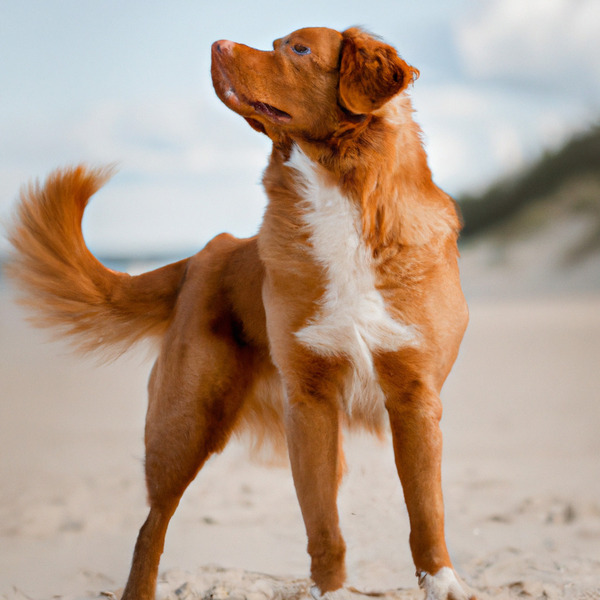Nova Scotia Duck Tolling Retriever vs. Pomeagle: Breed Differences and Similarities
Weight Gain Potential
Which breed eats more: Nova Scotia Duck Tolling Retriever or Pomeagle?
Both the Nova Scotia Duck Tolling Retriever and Pomeagle breeds have an average to high tendency to gain weight if their weight is not closely monitored. It is important to maintain a balance between exercise and food intake to keep them at a healthy weight. This can be achieved by scheduling at least one daily walk and engaging in regular playtime with them.
Hypoallergenic
Are Nova Scotia Duck Tolling Retrievers or Pomeagles hypoallergenic, or neither?
Unfortunately, neither Nova Scotia Duck Tolling Retriever nor Pomeagle are hypoallergenic, which may not make them the best choice for dog lovers who suffer from pet allergies.
Temperament
What are the personalities of Nova Scotia Duck Tolling Retriever and Pomeagle dogs?
Affectionate
Courageous
Gentle
Responsive
Alert
Energetic
Playful
Affectionate
Smart
Stubborn
Alert
Shedding Level
Do Nova Scotia Duck Tolling Retrievers shed more than Pomeagles, or which breed sheds more, Nova Scotia Duck Tolling Retrievers or Pomeagles?
Nova Scotia Duck Tolling Retrievers are moderate shedders, but regular brushing can reduce shedding and maintain coat health.
Pomeagles are heavy shedders, but regular brushing can help manage shedding and promote a healthy coat.
Watchdog Ability
Which dog breed makes a better watchdog, the Nova Scotia Duck Tolling Retriever or Pomeagle?
Nova Scotia Duck Tolling Retrievers are decent watchdogs - they'll alert their owner if something seems amiss.
Pomeagles make excellent watchdogs - they're vocal and protective of their territory.
Origin
What is the origin of Nova Scotia Duck Tolling Retriever and Pomeagle dog breeds?
Canada
United States
Ancestry
What are the origins of Nova Scotia Duck Tolling Retriever and Pomeagle breeds?
Cocker Spaniels, farm Collies, Irish Setters
Pomeranian, Beagle
Date of Birth
When were Nova Scotia Duck Tolling Retriever and Pomeagle breeds first developed?
19th Century
Unknown
Eye Color Possibilites
What are the eye colors of Nova Scotia Duck Tolling Retriever and Pomeagle dogs?
Hazel
Brown
Amber
Brown
Amber
Nose Color Possibilites
What are the natural nose colors of Nova Scotia Duck Tolling Retriever and Pomeagle?
Black
Brown
Black
Brown
Coat Color Possibilites
What are the natural colors of the coat for Nova Scotia Duck Tolling Retriever and Pomeagle breeds?
Red
Brown
Red
Fawn
White
Brindle
Black
Sable
Coat Length
What is the typical coat length for Nova Scotia Duck Tolling Retriever and Pomeagle breeds?
The coat of Nova Scotia Duck Tolling Retriever and Pomeagle dogs falls in the medium-length category.
Coat Density
What is the density of the coat of Nova Scotia Duck Tolling Retriever and Pomeagle?
Coat Texture
What is the hair texture of Nova Scotia Duck Tolling Retriever and Pomeagle?
Straight
Litter Size
What is the usual litter size for Nova Scotia Duck Tolling Retriever and Pomeagle?
A Nova Scotia Duck Tolling Retriever can have a litter of 12-14 puppies on average. However, it's worth noting that the size of the litters can vary greatly. Factors that can influence litter size include the health of the mother, breeding history, and genetics.
A Pomeagle can have a litter of 12-15 puppies on average. However, it's worth noting that the size of the litters can vary greatly. Factors that can influence litter size include the health of the mother, breeding history, and genetics.
Adaptability
Nova Scotia Duck Tolling Retrievers are highly adaptable and versatile, making them excellent companions for families and individuals of all lifestyles.
Pomeagles have average adaptability to changes in lifestyle and living environments compared to other breeds.
Health Issues
Between Nova Scotia Duck Tolling Retriever and Pomeagle, which breed is more prone to health problems?
Nova Scotia Duck Tolling Retrievers typically have low vet costs due to their good health, but it's important to monitor their health and seek vet care when necessary.
While the Pomeagle breed is generally healthy, occasional vet check-ups are still necessary to address any health concerns.
Major Concerns
What are the major health concerns for Nova Scotia Duck Tolling Retriever and Pomeagle breeds?
Hip Dysplasia
Progressive Retinal Atrophy (PRA)
Patellar Luxation
Canine Hip Dysplasia
Epilepsy
Hypothyroidism
Invertebral Disc Disease
Minor Concerns
What minor health issues should be kept in mind when owning Nova Scotia Duck Tolling Retriever and Pomeagle?
Collie Eye Anomaly (CEA)
Ear Infections
Eye Problems
Occasional Tests
What occasional tests are recommended for Nova Scotia Duck Tolling Retriever and Pomeagle breeds?
OFA
CERF
Hearing Tests
CT or MRI scan
Blood Electrolytes
Spinal Tap
Ear Tests and Myringotomy Tests
Complete Physical Examination
Full Chemistry Panel Tests and Blood Count
Skin Scrapings and Biopsies
X-rays or other radiographic imaging
Blood Glucose Level Testing
Eye and Otoscopic Examination
Energy
How do the energy levels of Nova Scotia Duck Tolling Retrievers and Pomeagles compare?
Nova Scotia Duck Tolling Retrievers thrive on an active lifestyle due to their high-energy nature.
Pomeagles' high energy levels make them unsuitable for a low-key dog, choose accordingly.
Social Needs
Nova Scotia Duck Tolling Retriever vs Pomeagle social needs comparison
Nova Scotia Duck Tolling Retriever has above average social needs and thrives with interaction with humans and other dogs.
Pomeagle has very high social needs and requires regular mental and physical stimulation, a job or purpose, and companionship.
Exercise Needed
Nova Scotia Duck Tolling Retriever vs Pomeagle exercise need comparison.
Nova Scotia Duck Tolling Retrievers require significant physical activity and suit those with an active lifestyle.
Pomeagles need moderate physical activity and are great for families and active individuals.
Sleeping Need
Which of the two sleeps the most/least: Nova Scotia Duck Tolling Retriever or Pomeagle?
Nova Scotia Duck Tolling Retrievers are active and require sufficient sleep to stay healthy.
Pomeagles sleep less than other breeds but still need adequate sleep for good health.
Drooling Tendency
Which drools more/less, Nova Scotia Duck Tolling Retriever or Pomeagle?
The Nova Scotia Duck Tolling Retriever and Pomeagle breeds are known for their low drooling tendencies, making them a suitable choice for people who don't want to deal with drool marks on their clothing.
Tendency to Bark
Do Nova Scotia Duck Tolling Retrievers or Pomeagles bark more/less frequently?
Nova Scotia Duck Tolling Retrievers bark moderately when necessary and may also bark due to certain triggers like fear, alarm, boredom, greeting, separation anxiety and compulsive barking.
Pomeagle dogs bark and howl frequently and are not recommended for quiet homes.
Territorial
Is the Nova Scotia Duck Tolling Retriever or Pomeagle a better guard dog?
While Nova Scotia Duck Tolling Retriever dogs can defend their territory or owners, it's not their primary trait, and they are not ideal guard dogs.
Pomeagle dogs have a strong protective nature and territorial instinct. They are highly vigilant and will fiercely defend their home and family.
Mouthiness
Mouthiness Comparison: Nova Scotia Duck Tolling Retriever vs Pomeagle?
Roaming urge
Nova Scotia Duck Tolling Retriever vs Labrador: Running away tendency?
Prey Drive
Nova Scotia Duck Tolling Retriever or Pomeagle - which breed has a higher level of prey drive?
Past times
What are some enjoyable activities and ways to keep Nova Scotia Duck Tolling Retriever and Pomeagle entertained?
Fetch, Bike ride, Dog Parks, Walk, Run
Walking, Beach, Walks, Playing fetch, Cuddling, Socializing
Activity Level
Which breed has higher energy, Nova Scotia Duck Tolling Retrievers or Pomeagles?
Nova Scotia Duck Tolling Retrievers are high-energy dogs. They need mental as well as physical exercise. These dogs require a lot of your involvement and without it they can, and will, become problematic dogs.
Pomeagles are medium-energy dogs and typically enjoy socializing and playing casual or even sustained games of chase with other dogs. They may also have occasional periods of barking or racing around the house.
Tolerance of being left alone
Walks per Week
How many miles should Nova Scotia Duck Tolling Retriever or Pomeagle walk each week?
There's really no limit to how far you walk your dog as long as they're comfortable. For Nova Scotia Duck Tolling Retriever, it's at least 10 miles / week. Just remember to build distance and stamina gradually over time.
There's really no limit to how far you walk your dog as long as they're comfortable. For Pomeagle, it's at least 8 miles / week. Just remember to build distance and stamina gradually over time.
Activity per Day
Do Nova Scotia Duck Tolling Retrievers or Pomeagles require more exercise?
In general most Nova Scotia Duck Tolling Retrievers usually need at least 60 minutes of exercise daily. This can be spread across the day and include all sorts of high-energy activities, like walking, running and playing.
In general most Pomeagles usually need at least 45 minutes of exercise daily. This can be spread across the day and include all sorts of high-energy activities, like walking, running and playing.
Grooming
Which breed is easier to maintain in terms of grooming, Nova Scotia Duck Tolling Retrievers or Pomeagles?
The Nova Scotia Duck Tolling Retriever has low grooming needs and is easy to maintain.
Pomeagles require significant grooming, including regular trims and professional grooming assistance to maintain their coat. They may also require frequent bathing to keep their coat and skin healthy.
Brushing Frequency
What is the recommended brushing frequency for Nova Scotia Duck Tolling Retriever and Pomeagle dogs?
Nova Scotia Duck Tolling Retriever and Pomeagle should be brushed at least once a week. Of course, you can give them more frequent brushes if you find that they are still shedding a lot.
Brushing Tools
What brushing tools are used for Nova Scotia Duck Tolling Retrievers and Pomeagles?
Pin Brush
Dematter
Comb
Nail Clipper
Pin Brush
Slicker Brush
Nail Clipper
Cups
How much food should be given to Nova Scotia Duck Tolling Retriever or Pomeagle in cups?
For an average 44-51 pound (20 - 23 kg) Nova Scotia Duck Tolling Retriever feed 2.3 cups daily. But, keep in mind, the amount you feed is going to be dependent on the quality of the food you are feeding.
For an average 6-25 pound (3 - 11 kg) Pomeagle feed 1 cups daily. But, keep in mind, the amount you feed is going to be dependent on the quality of the food you are feeding.
Daily Cost
Which breed has a higher daily cost, Nova Scotia Duck Tolling Retriever or Pomeagle?
The average cost of a Nova Scotia Duck Tolling Retriever is somewhere $1.70 - $2.00 per day.
The average cost of a Pomeagle is somewhere $2.10 - $3.50 per day.
Monthly Cost
Which breed has a higher monthly cost, Nova Scotia Duck Tolling Retriever or Pomeagle?
The average per month expenses of a Nova Scotia Duck Tolling Retriever is between $48 - $63. This makes an average of $576 - $756 per year. It will be on the higher side when the dog is still small because it will need more frequent visits to the vet, shots.
The average per month expenses of a Pomeagle is between $36 - $49. This makes an average of $432 - $588 per year. It will be on the higher side when the dog is still small because it will need more frequent visits to the vet, shots.
Intelligence
Comparing Intelligence: Nova Scotia Duck Tolling Retrievers vs Pomeagles
Nova Scotia Duck Tolling Retriever and Pomeagle have below-average obedience intelligence compared to other breeds. However, calling them "dumb dogs" is unjust. While Nova Scotia Duck Tolling Retriever and Pomeagle lack obedience and working intelligence, they compensate for it with their remarkable ability to comprehend human emotions.
Sensitivity Level
How do Nova Scotia Duck Tolling Retriever and Pomeagle compare in sensitivity?
Nova Scotia Duck Tolling Retrievers have average emotions and adapt well to different situations.
This breed is sensitive and requires gentle handling and a calm home environment.
Affection Dependance
Which is the more affectionate dog breed: Nova Scotia Duck Tolling Retriever vs Pomeagle?
Apartment Friendly
Which breed is more apartment-friendly: Nova Scotia Duck Tolling Retriever or Pomeagle?
Nova Scotia Duck Tolling Retrievers are good apartment dogs as long as they get enough exercise and stimulation outside of the apartment.
The Pomeagle is a great apartment dog, thriving with sufficient exercise and time outside as part of their daily routine.
Child Friendly
Do Nova Scotia Duck Tolling Retrievers or Pomeagles have a friendlier temperament towards children?
Nova Scotia Duck Tolling Retrievers make excellent family pets for kids due to their gentle, protective nature and calm temperament.
Pomeagles have an average level of friendliness towards children.
Senior-friendly
Which dog is more suitable as a pet for the elderly - Nova Scotia Duck Tolling Retriever or Pomeagle?
Cat Friendly
Do Nova Scotia Duck Tolling Retriever or Pomeagle breeds have a better compatibility with cats?
Nova Scotia Duck Tolling Retrievers and Pomeagles are an average cat friendly dog. They do well with cats, even more if raised together from puppyhood.
Dog Friendly
Which breed is more sociable with other dogs: Nova Scotia Duck Tolling Retriever or Pomeagle?
Nova Scotia Duck Tolling Retrievers are generally very friendly towards other dogs, with a happy and affectionate temperament.
Pomeagles are average in their friendliness towards other dogs, and socialization can help.
Pet friendly
How do Nova Scotia Duck Tolling Retriever or Pomeagle dogs interact with other pets?
Stranger Friendly
Which breed is more friendly with strangers: Nova Scotia Duck Tolling Retriever or Pomeagle?
Nova Scotia Duck Tolling Retrievers are quick to announce strangers and can be standoffish or suspicious.
Pomeagles are averagely friendly around strangers but benefit from early socialisation.
Playfulness
Which breed is more playful between Nova Scotia Duck Tolling Retriever and Pomeagle?
Nova Scotia Duck Tolling Retrievers are very playful, so adopting an older one might be a better option for a more relaxed experience.
Pomeagles are a playful breed that needs daily playtime to be happy.
Trainability
How do the trainability levels of Nova Scotia Duck Tolling Retrievers and Pomeagles compare?
Nova Scotia Duck Tolling Retrievers are popular for their ease of training and quick learning ability.
Pomeagles are usually easy to train but require consistency to fully obey commands.
Compare Nova Scotia Duck Tolling Retriever with other breeds

Mastapeake
Nova Scotia Duck Tolling Retriever vs Mastapeake

Belgian Tervuren
Nova Scotia Duck Tolling Retriever vs Belgian Tervuren

Hanover Hound
Nova Scotia Duck Tolling Retriever vs Hanover Hound

Plott Hound
Nova Scotia Duck Tolling Retriever vs Plott Hound

Cursset
Nova Scotia Duck Tolling Retriever vs Cursset

Italian Greyhound
Nova Scotia Duck Tolling Retriever vs Italian Greyhound

Miniature Ausseippet
Nova Scotia Duck Tolling Retriever vs Miniature Ausseippet

Yorkshire Terrier
Nova Scotia Duck Tolling Retriever vs Yorkshire Terrier

Jack Russell Terrier
Nova Scotia Duck Tolling Retriever vs Jack Russell Terrier

Schnorgi
Nova Scotia Duck Tolling Retriever vs Schnorgi

Engatzu Spaniel
Nova Scotia Duck Tolling Retriever vs Engatzu Spaniel

Cane Corxer
Nova Scotia Duck Tolling Retriever vs Cane Corxer

